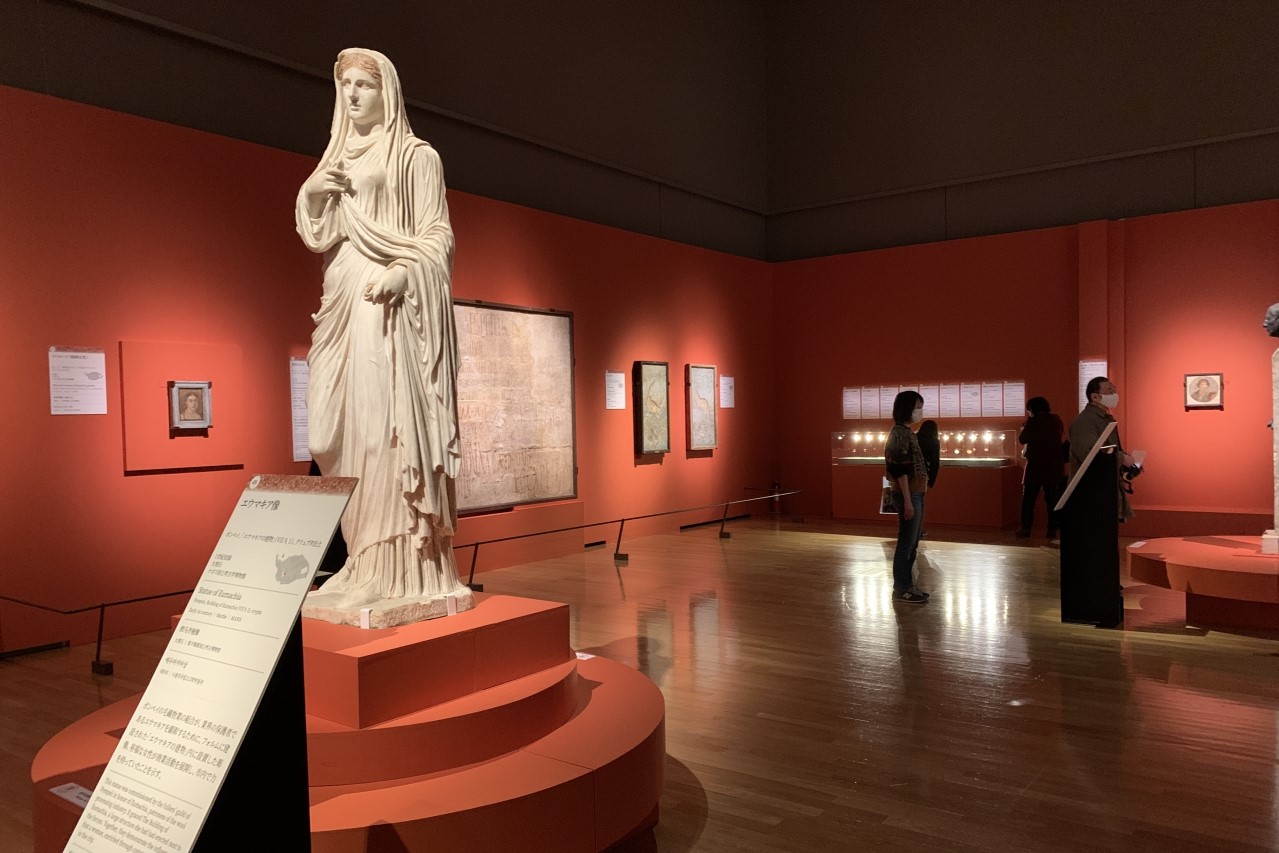
Pompeii, a city of the Roman Empire that once existed in southern Italy and disappeared with the eruption of a volcano about 2000 years ago. A special exhibition "Pompeii" is being held at the Tokyo National Museum Heiseikan in Ueno, Tokyo, which introduces the prosperity and people's lives with about 150 excavated items. The session will be from January 14th (Friday) to April 3rd (Sunday), 2022.
Since I participated in the press preview held prior to the event, I will report on the state of the venue and the exhibited works.
* All works not mentioned in the caption are in the collection of the National Archaeological Museum of Naples.
Introducing about 150 masterpieces including the first public release in Japan!

Venue scenery
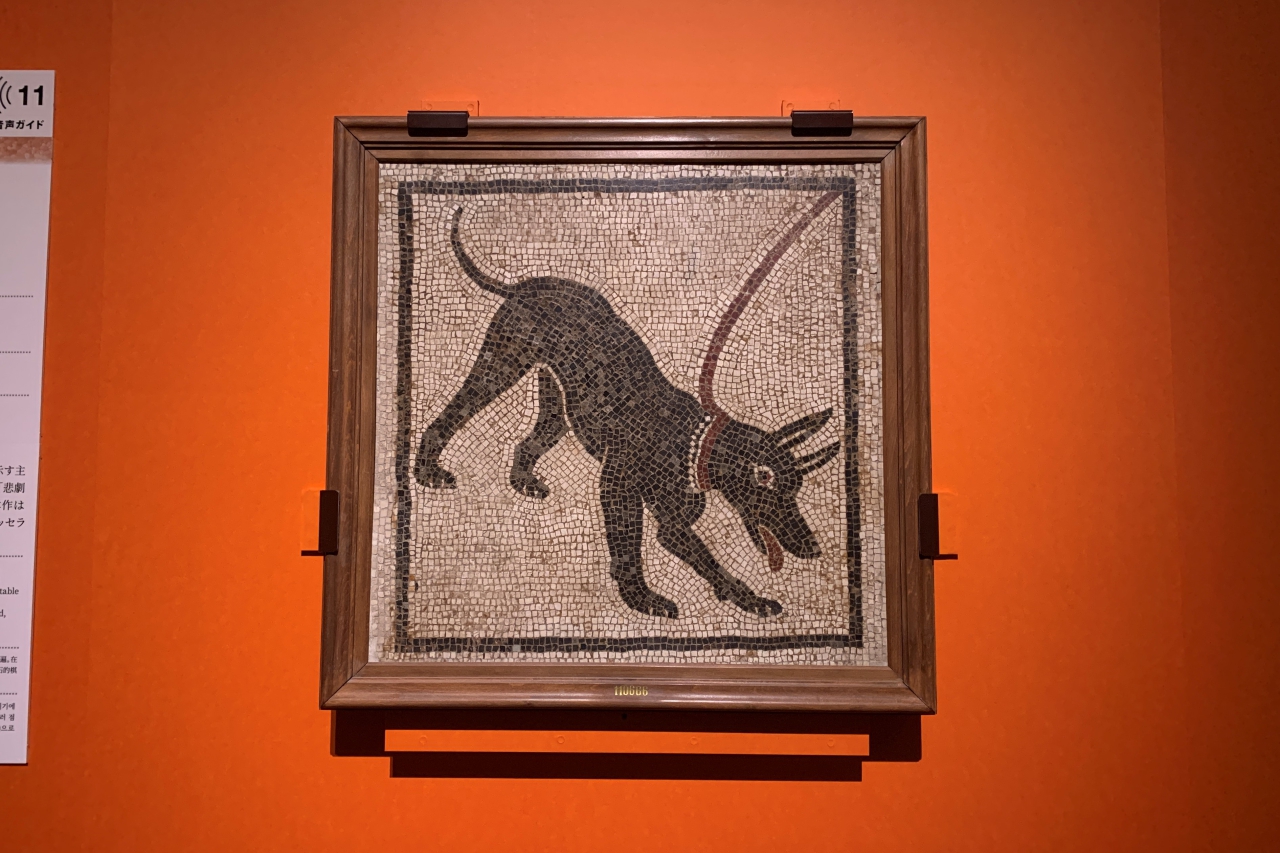
Venue scenery, "Cave canem" (1st century)
Pompeii, a provincial city of the Roman Empire, was a scenic land where about 10,000 people lived and was suitable for the production of wine and olive oil. In 79 AD, a large eruption occurred on Mount Vesuvius in the northwest of the city, and it was a tragic city that was completely buried all day and night.
The ruins, which are 1600m east-west and 800m north-south, are like a time capsule that kept the bustle of the city asleep for about 1700 years until the start of full-scale excavation in the 18th century. As a treasure trove of valuable materials that give you an idea of the appearance of the ancient Roman city, vigorous archaeological research is still ongoing.
The special exhibition "Pompeii" is about 150, including the first public exhibition in Japan, including mosaics, murals, statues, and daily necessities that the museum is proud of, with the full cooperation of the National Archaeological Museum of Naples, which holds many excellent items excavated from Pompeii. An exhibition of dots. It is a valuable exhibition where you can feel the breath of the people who lived in the city that prospered 2000 years ago.
From now on, I will introduce the contents of the exhibition from the beginning to the 5th chapter of this exhibition.
Preface: Mount Vesuvius eruption and Pompeii burial
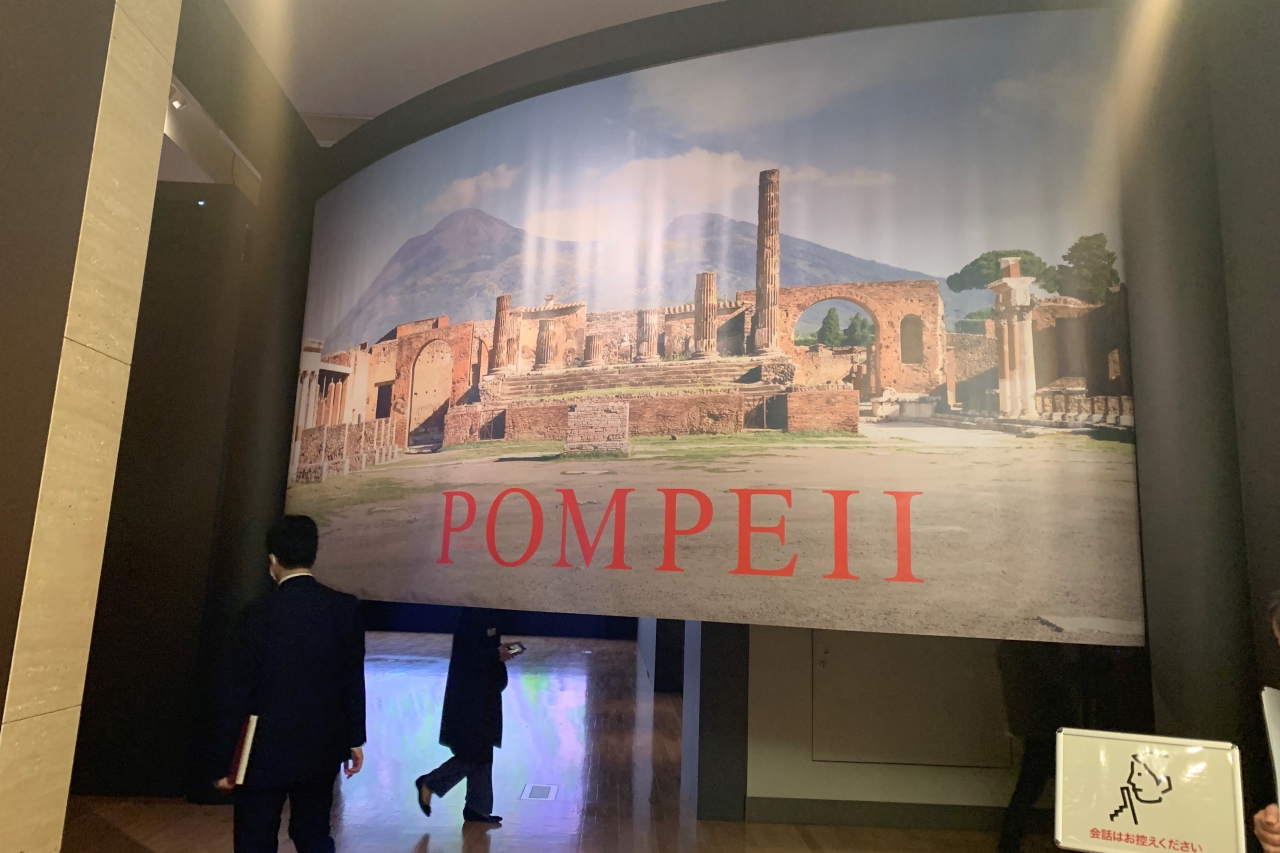
Preface, entrance
The introduction introduces the situation before and after the eruption of Mount Vesuvius. There are several huge displays of high-definition images in this exhibition, but the eruption CG images in the introductory part are particularly impressive. How the city of Pompeii was swallowed was realistically depicted, and it was a moving experience for a person living in Japan, which has many active volcanoes.

"Gypsum statue of a female victim" (1979/1875)
There is also an exhibition of "Gypsum Statue of Female Victims" right next to it. Occasionally, the solidified volcanic ash creates cavities due to the decomposition of organic matter, and when plaster is poured into it, plaster statues such as human bodies are created. Although it does not contain a corpse, it has a vivid presence.
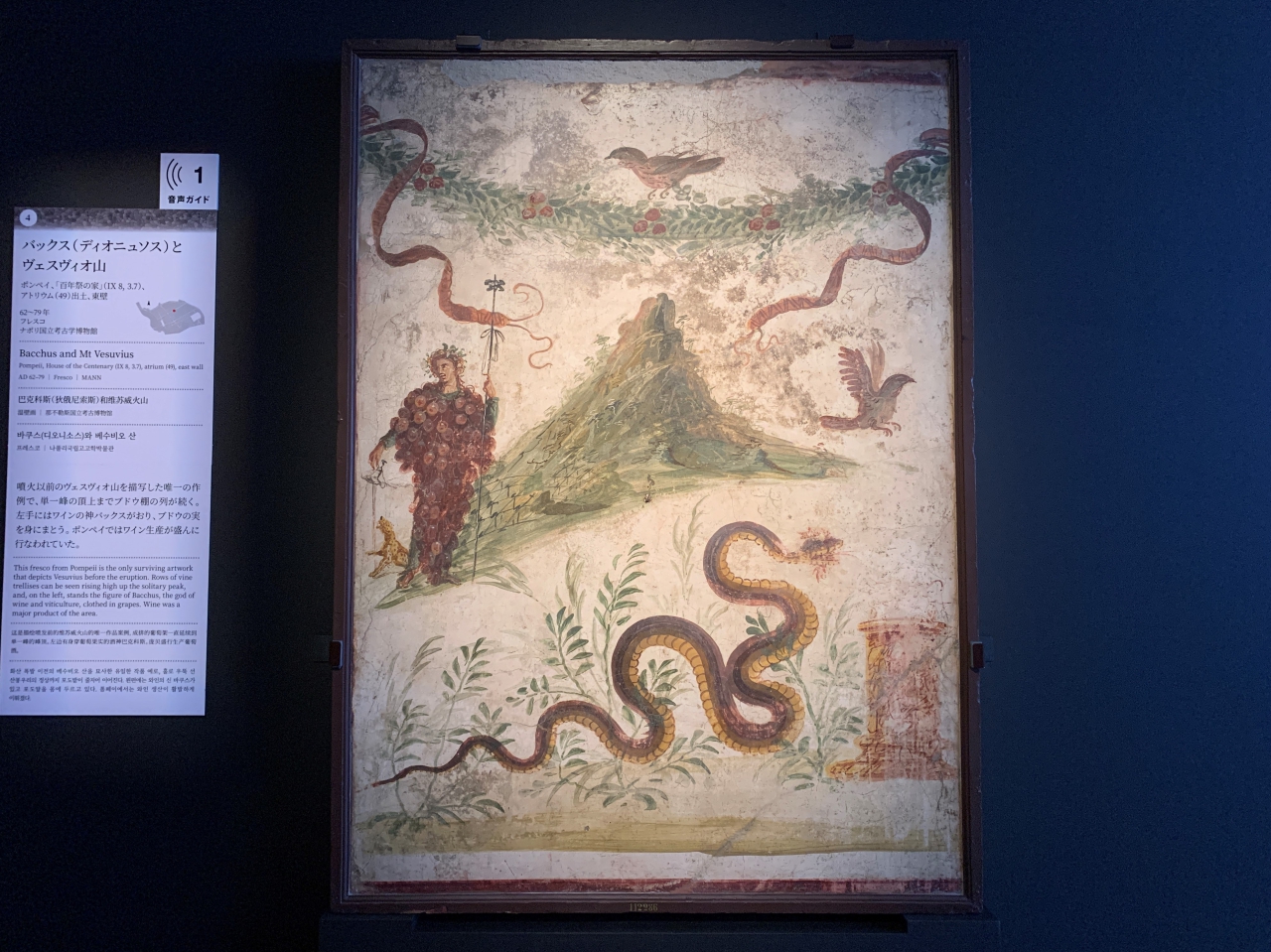
"Bucks (Dionysus) and Mount Vesuvius" (62-79)
Also, in the fresco "Bucks (Dionysus) and Mount Vesuvius", which is the only example of the painting of Mount Vesuvius before the eruption, you can see the appearance of the mountain before it was greatly deformed. It's a very rare document, but I'm drawn to the surrealism of the Roman god of wine, Bucks, whose whole body is wrapped in grapes rather than the mountains.
Chapter 1: City of Pompeii-Public Architecture and Religion
Chapter 1 introduces works related to public facilities such as Pompeii's form (central square), theaters, amphitheaters, baths, and playgrounds, as well as works related to religion and religion.
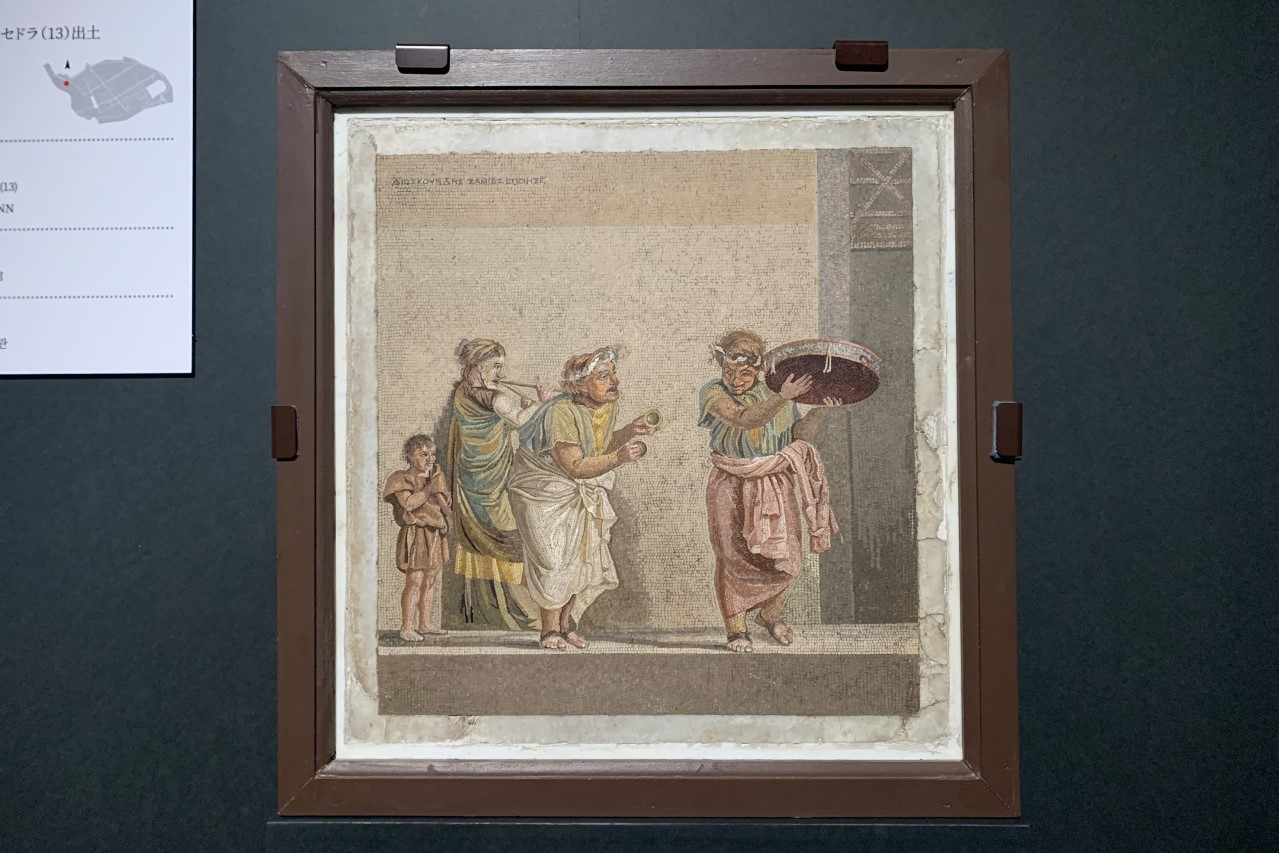
"Tsuji Musician" (1st century BC)
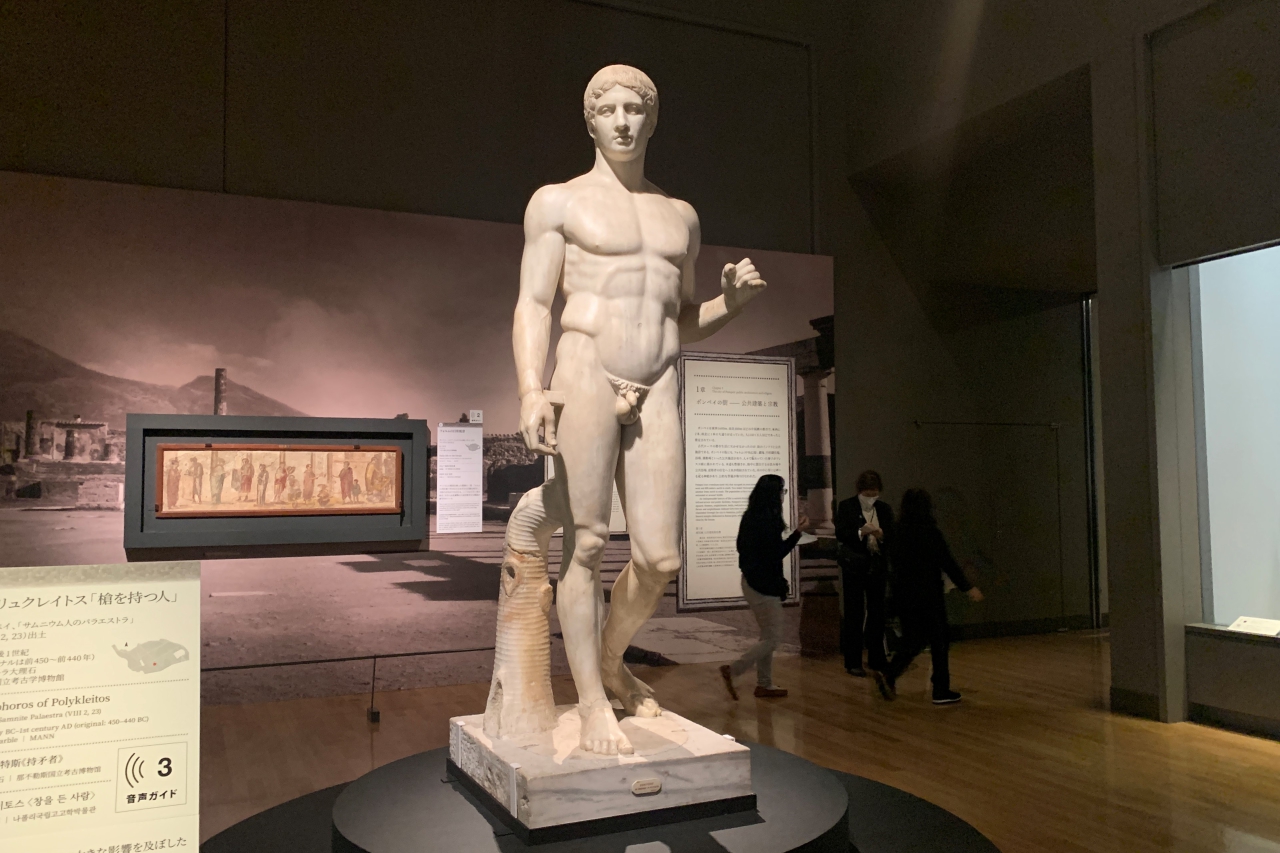
Polykleitos "People with Spears" (1st century BC-1st century BC, original 450-440 BC)
The mosaic painting "Tsuji Ongakushi", which was adopted as the main visual of this exhibition, which shows the popularity of theater at that time, and the marble model of Polykleitos's "Doryphoros", which had a great influence on the human body expression of Western art. Full of highlights such as ticks!
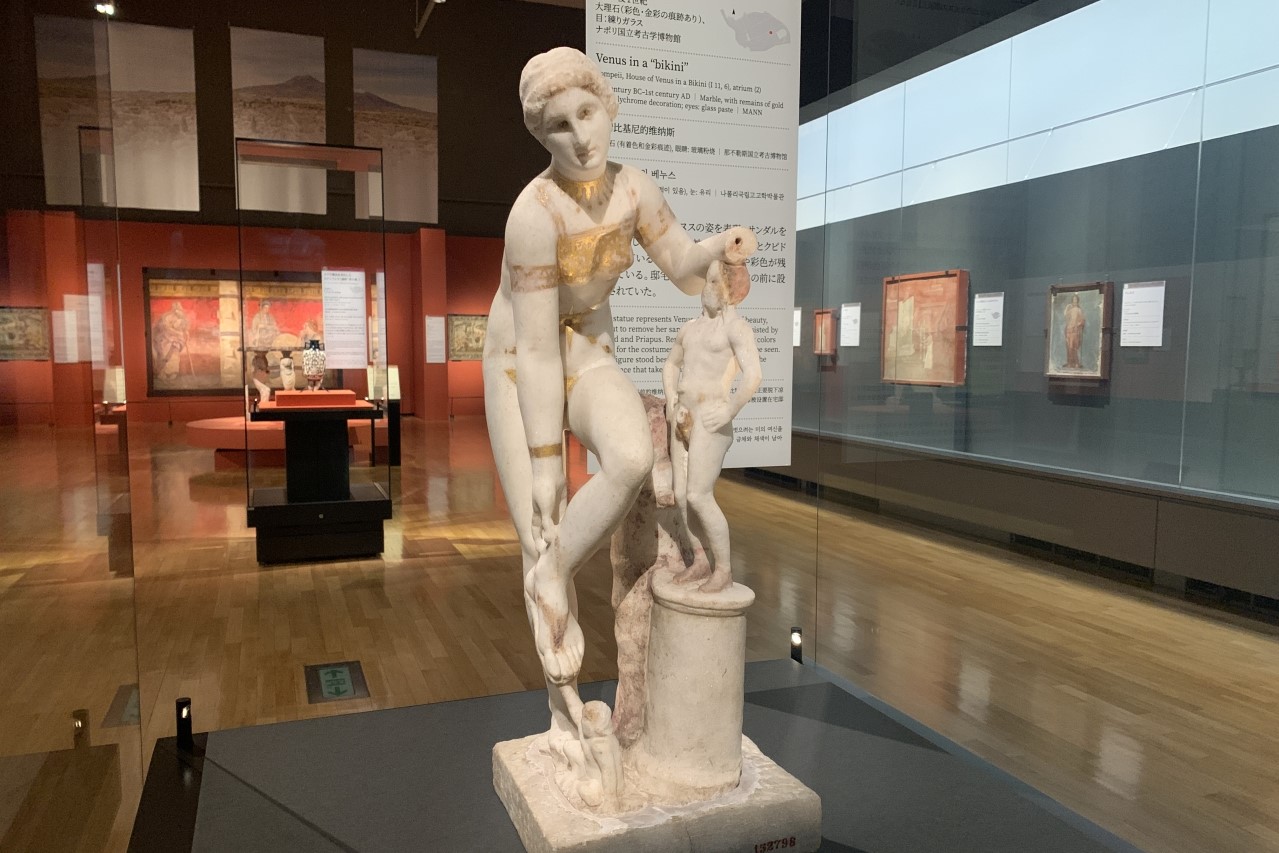
"Venus in Bikini" (1st century BC-1st century BC)
"Venus in Bikini", which expresses Venus, the goddess of beauty who takes off her sandals just before bathing, has beautiful gold accessories. Venus is the guardian deity of Pompeii, and it seems that a temple was also built in the city, but this marble statue was displayed in the hall of the mansion.
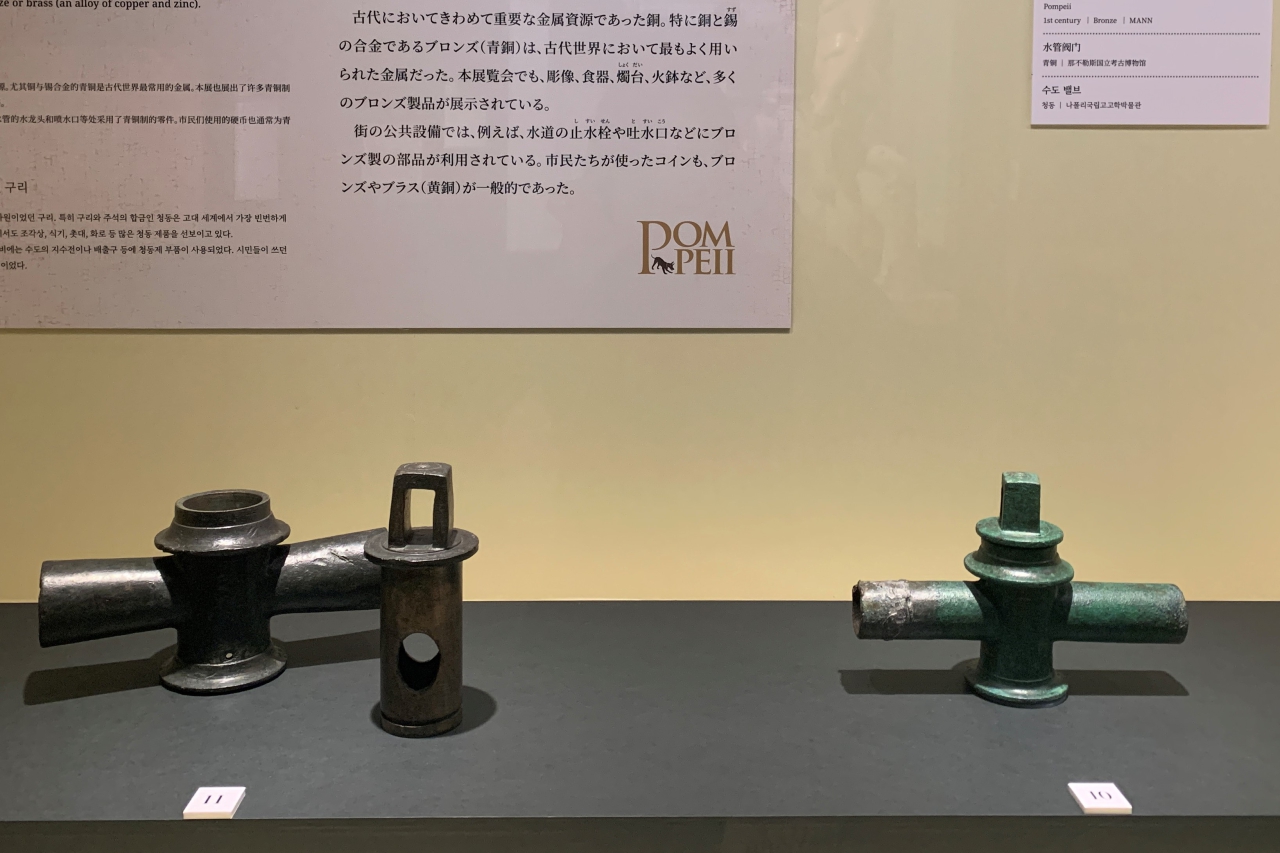
"Water valve" (1st century)
Also, as an inconspicuous but surprising exhibition, I would like to recommend a water valve that was widely used in Pompeii. If you look into it, you can see how the ancient Romans had reached a high level of technology in the field of hydraulics, since it was around the 16th century that water services appeared in earnest in Japanese history.
Chapter 2 Pompeii Society and People's Activities
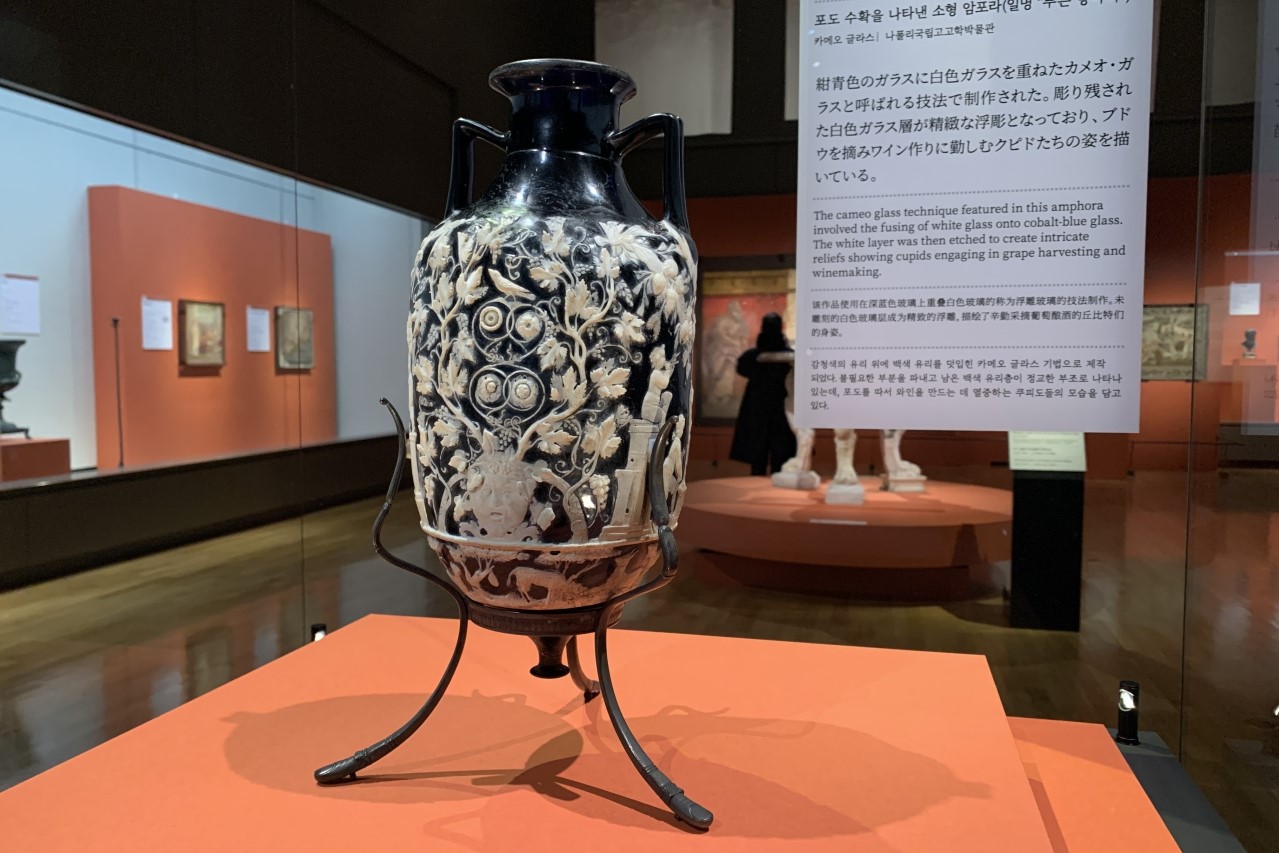
"Small amphora representing grape picking (commonly known as" blue jar ")" (first half of the 1st century)
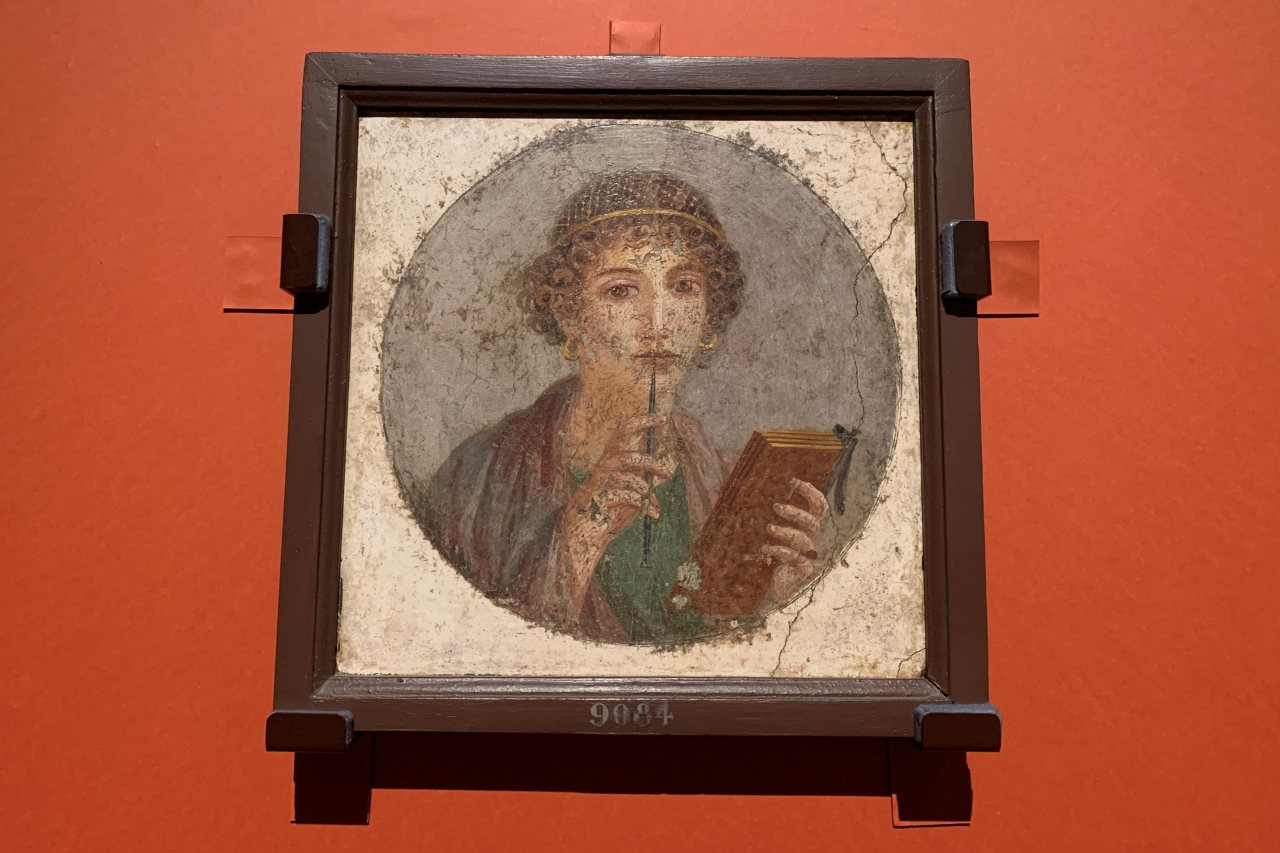
<< A woman with a writing board and a stylus (commonly known as "Sappho") >> (1950-79)
Chapter 2 exhibits excavated items such as lifestyle furnishings and decorations that convey the lifestyle of wealthy citizens who lived in the city of Pompeii. From there, the existence of wealthy people such as women of low origin and freed slaves who have risen with business talents also emerges, and the surprising liquidity of ancient Roman society where the difference between rich and poor was wide can be seen.
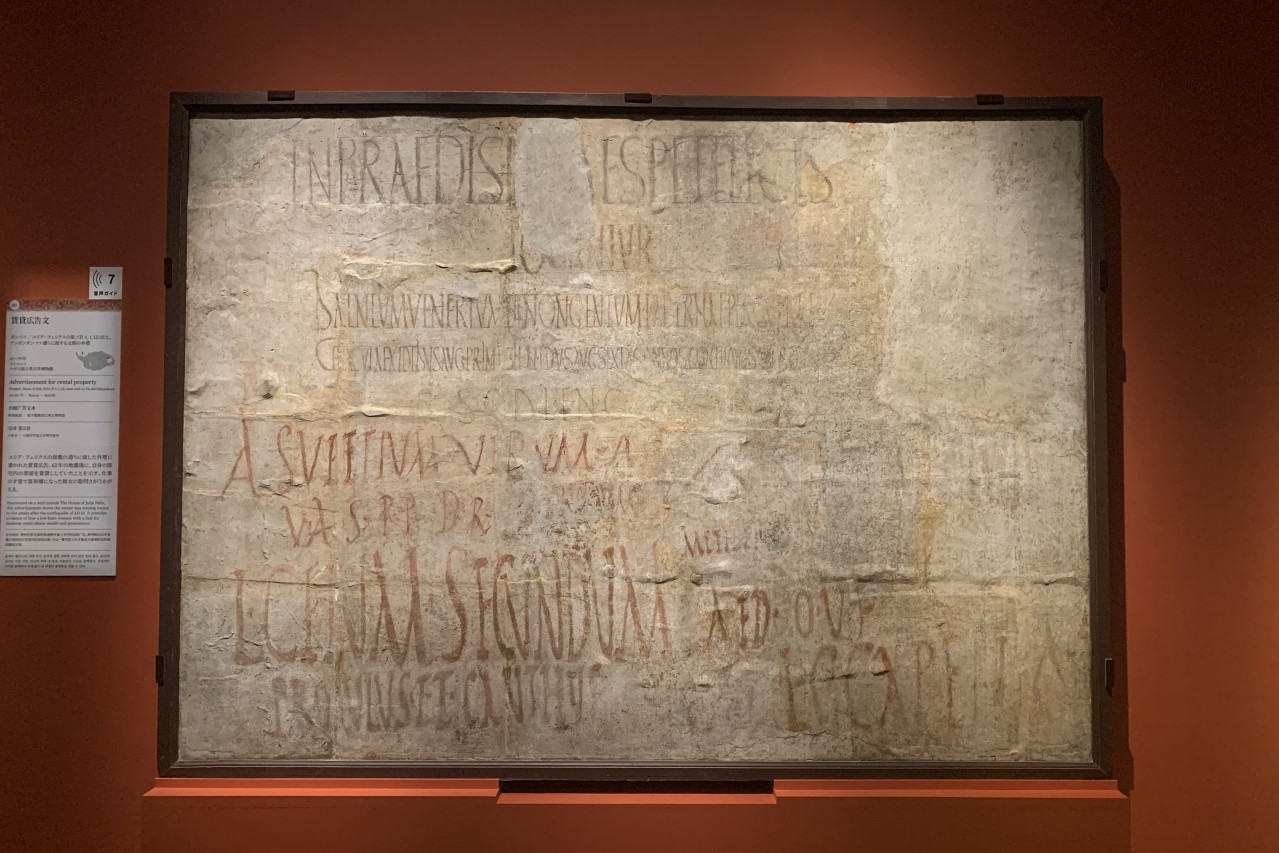
"Rental advertisement" (1987-79)
What's interesting is this kind of rock with big letters. Actually, this is a rental advertisement written on the outer wall of the mansion. If you think that it is the same as the advertisement of "Recruitment of residents!" That we often see in the city, the realization that "I really lived there" comes to me at once.
It seems that the advertisement text says as follows. "At the mansion of Julia, daughter of Spryus Felix, elegant bathrooms, stores, mezzanine and upstairs rooms for well-behaved people, from August 13th to August 13th, the sixth year, 5 It will be rented annually. SQDLENC (Omitted) "
Julia Felix, who ran a real estate leasing business, is also a good example of a wise woman who has become a wealthy person with a talent for work.
Chapter 3: People's Lives-Food and Work
Chapter 3 exhibits kitchen utensils, tableware, and excavated ingredients to help you understand your eating habits. It also introduces work tools used by Pompeii residents, such as medical tools, painting materials, farm tools, and tools, and focuses on the daily lives of the people who lived in Pompeii.
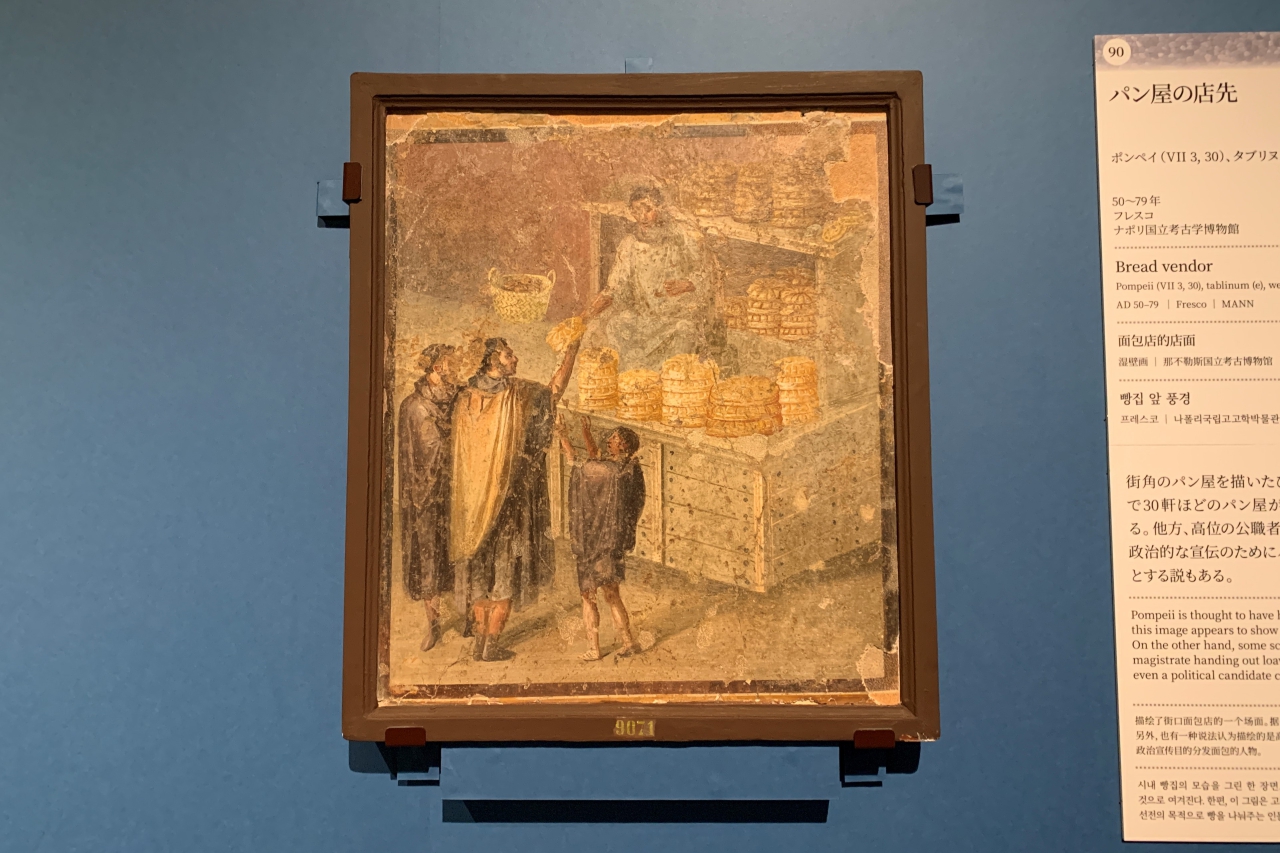
"Bakery storefront" (50-79)
There are about 30 bakeries and take-out restaurants in Pompeii, so it was easy to eat. The fresco "Bakery storefront" depicts bread shaped like a disk-shaped pie, but the bread as it was drawn in the picture was excavated from the ruins and exhibited in this exhibition. ..
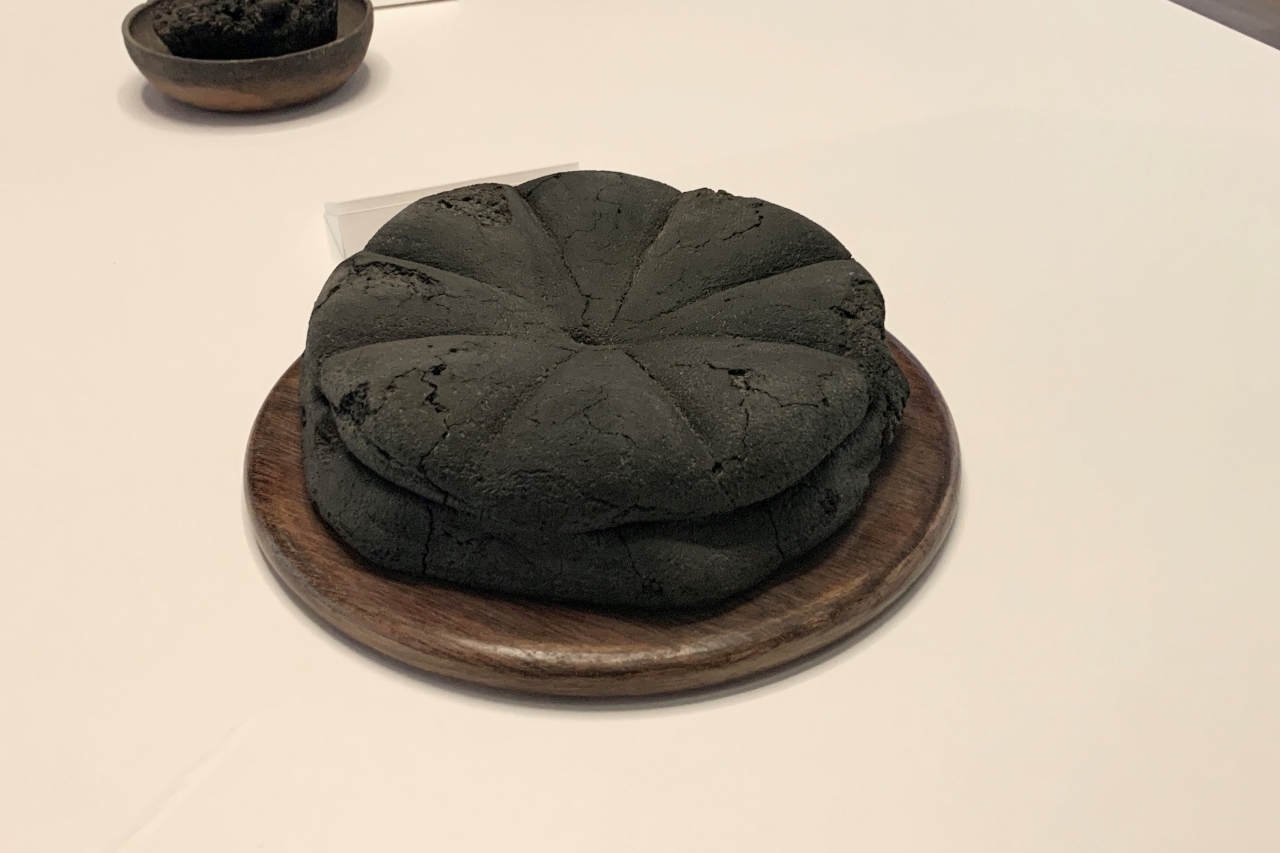
"Carbonized bread" (1979)
I was impressed that the carbonized bread kept its shape so plump. This is a typical bread called "Panis Quadratus", and it was said that a knife was used to make radial cuts before baking to make it easier to separate.
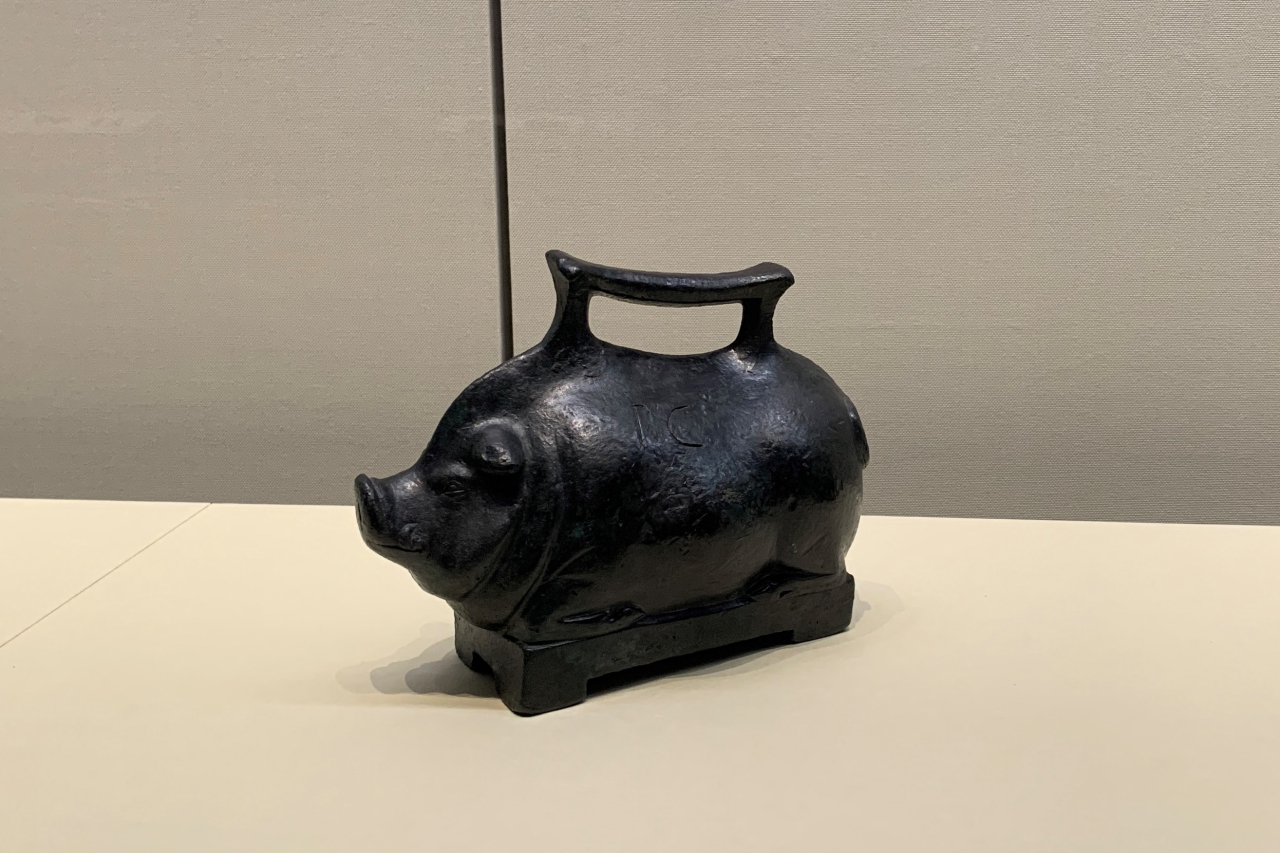
"Pig-shaped weight" (1st century)
Even with daily miscellaneous goods such as cooking utensils and scales, you can see that many of them are sophisticatedly decorated with a little scrutiny. Some of the works have animal motifs, and the weight is in the shape of a piglet, which is humorous and makes me laugh.
Chapter 4: History of Pompeii Prosperity
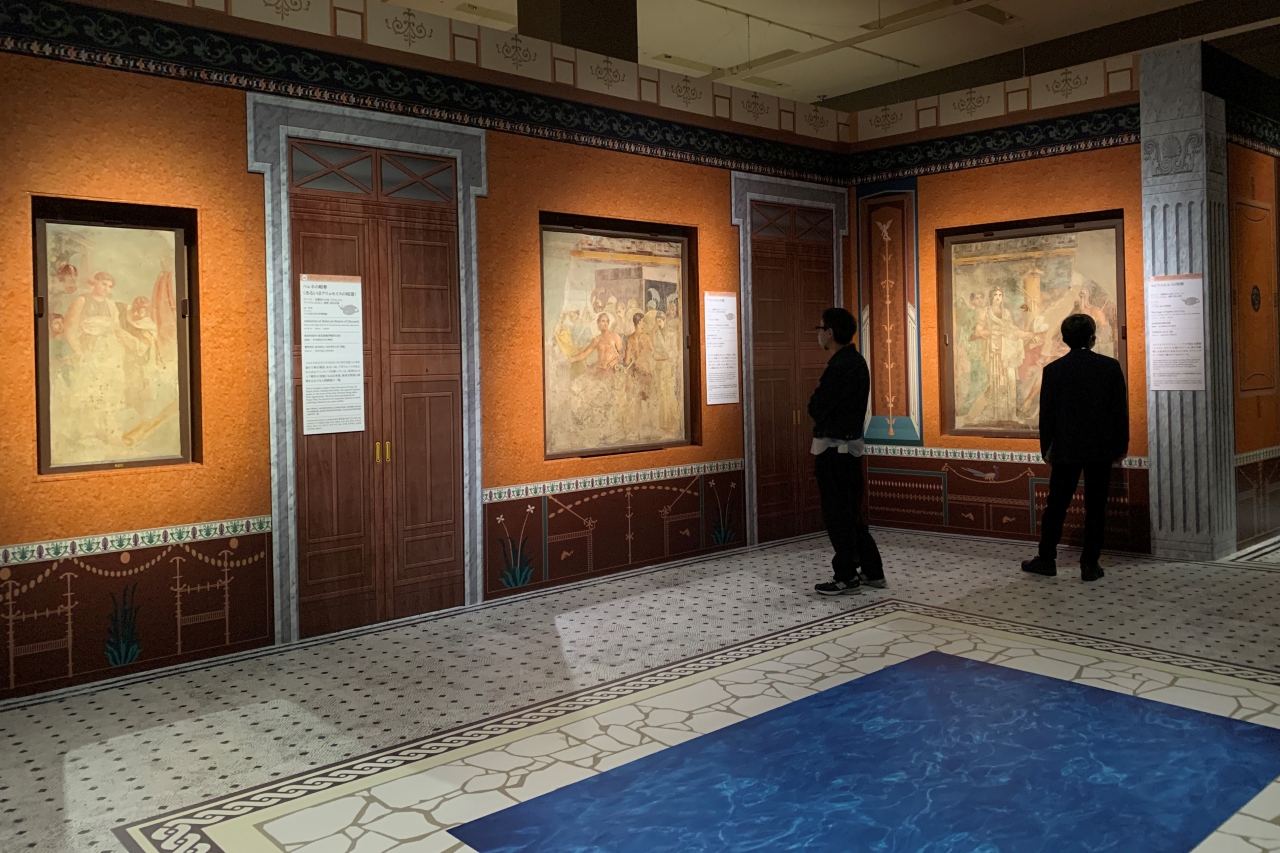
Partial reproduction exhibition of "House of the Tragic Poet"
Chapter 4 is the highlight of this exhibition. Part of the three mansions "House of the Tragic Poet", "House of the Tragic Poet" and "House of the Fauns" showing the history of Pompeii's prosperity are reproduced in the venue! It is an exhibition space where you can feel the atmosphere of a 2000-year-old mansion while appreciating masterpieces of mosaics and murals.
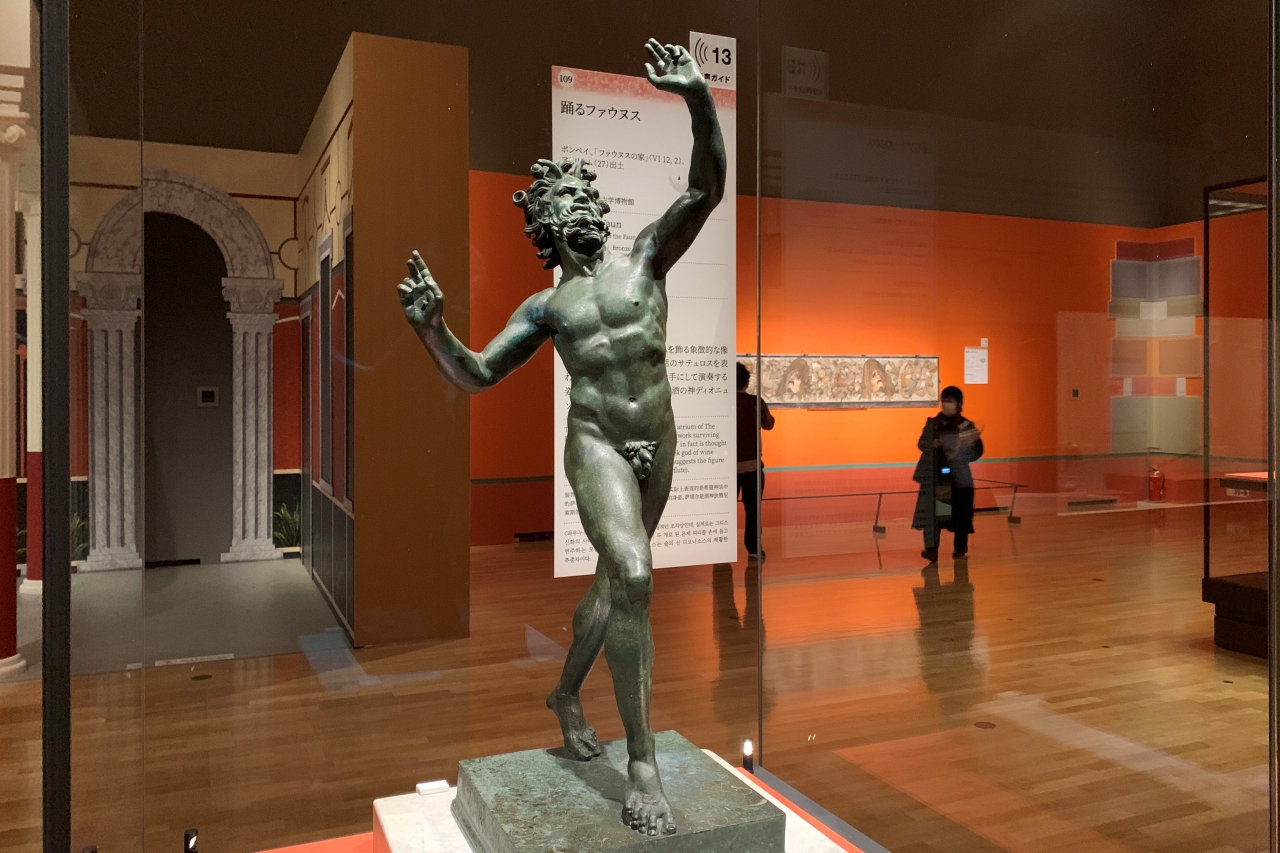
"Dancing Faun" (2nd century BC)

"Dicotyledon and Tragedy Mask" (end of 2nd century BC)
The most striking is the exhibition of the "House of the Fauns", which was built around the 2nd century BC and retains the richness of pre-Romanization Hellenistic culture. It is the largest mansion in Pompeii, which occupied all of one block (about 3,000 m2). Here, the dynamic bronze statue of Faun, the origin of the "House of the Faun", "Dancing Faun", and the beautiful and terrifying floor mosaic "Faun and the Mask of Tragedy" made by a detailed technique called Ops Welmicratum. You can appreciate such things.

Partial reproduction exhibition of "House of the Faun"
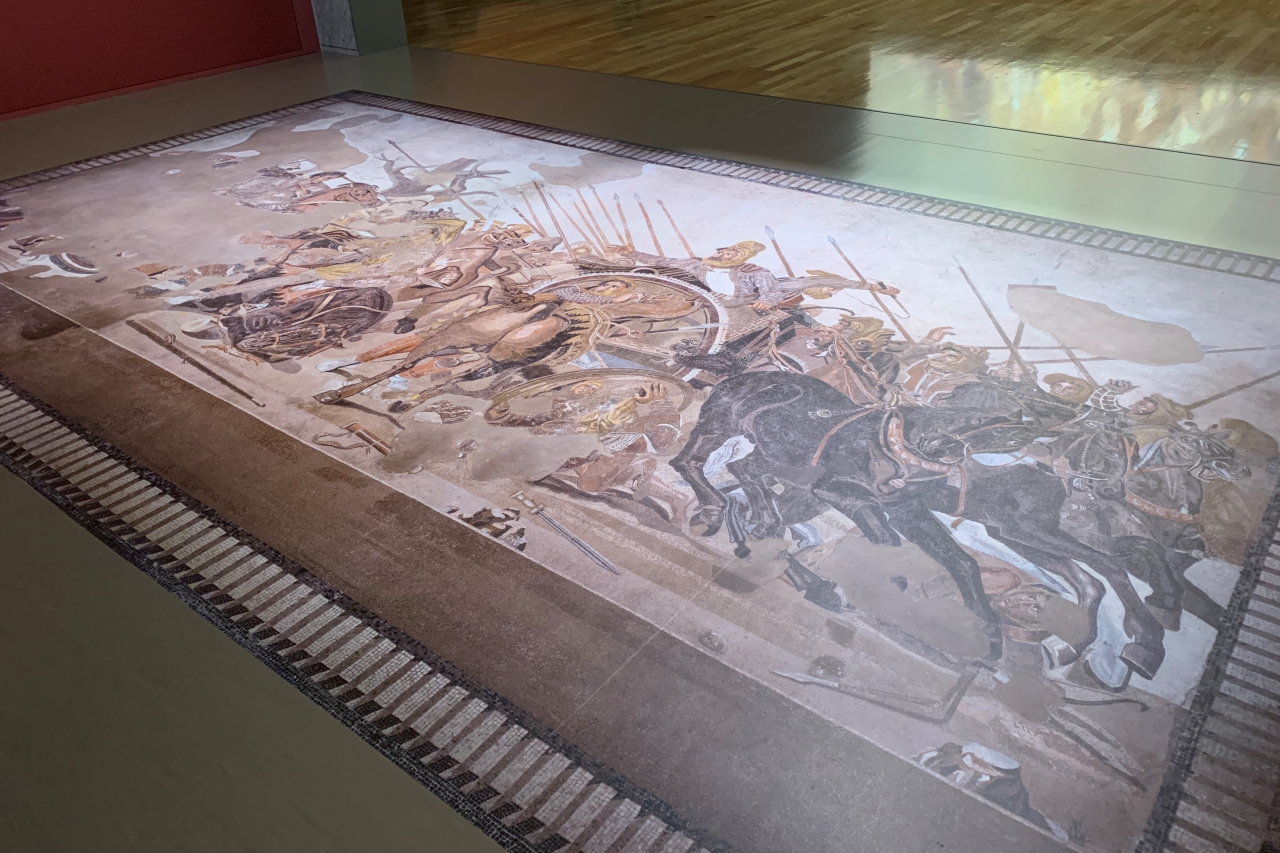
A reproduction exhibition of "House of the Faun", and a reproduction of "Alexander the Great's Mosaic" on the floor .
Also, what was discovered in the lounge of this "House of the Faun" was the masterpiece of the famous mosaic painting "Mosaic of Alexander the Great". Unfortunately, this work, which depicts the "Battle of Issus" in which the Macedonian army led by Alexander the Great defeated the Persian army led by Darius III, is still under restoration work, but this exhibition can be enjoyed in full-scale 8K high-definition video. increase. A copy of the same work was laid on the floor in front of the display, and it was possible to walk by stepping on the popular house at that time.
Chapter 5: Now of excavation, long ago
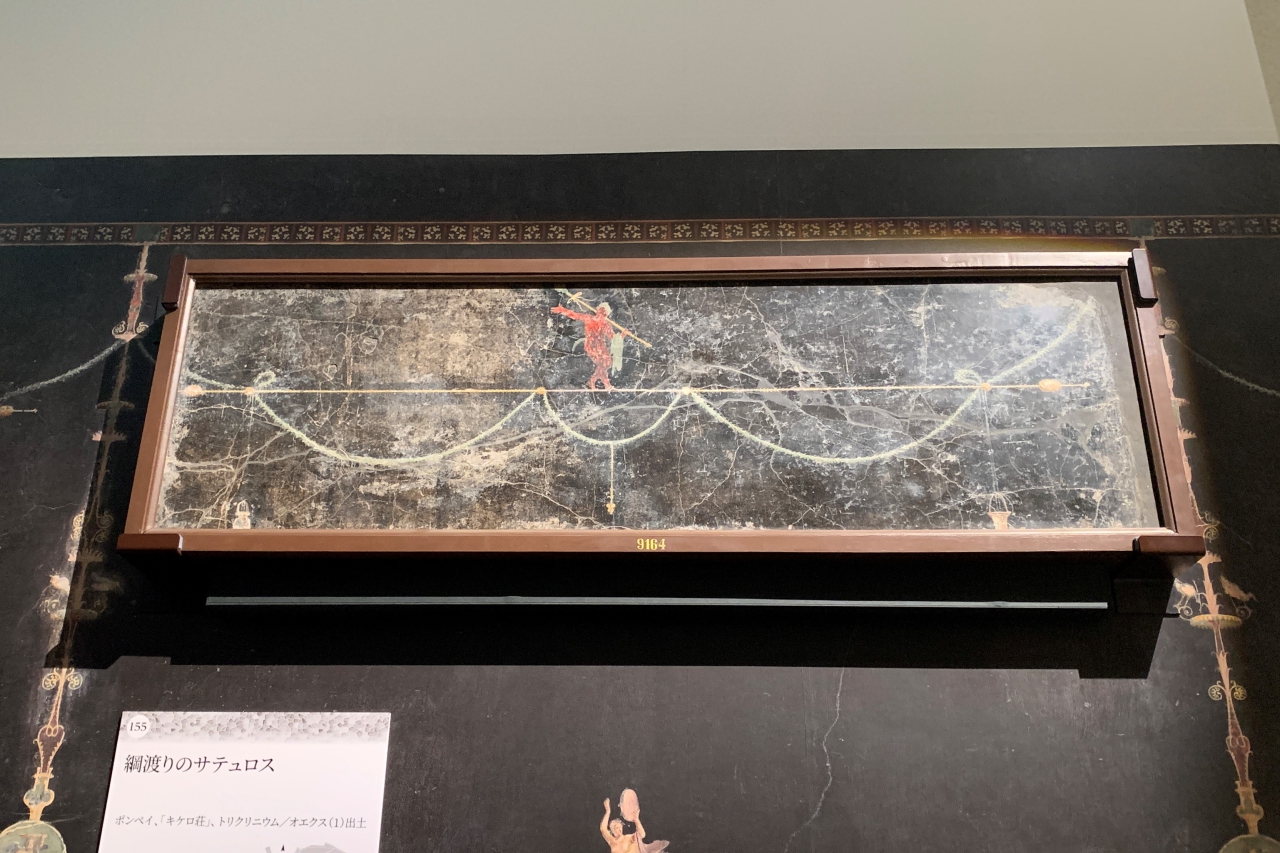
"Tightrope walking satyr" (15-50 years before)
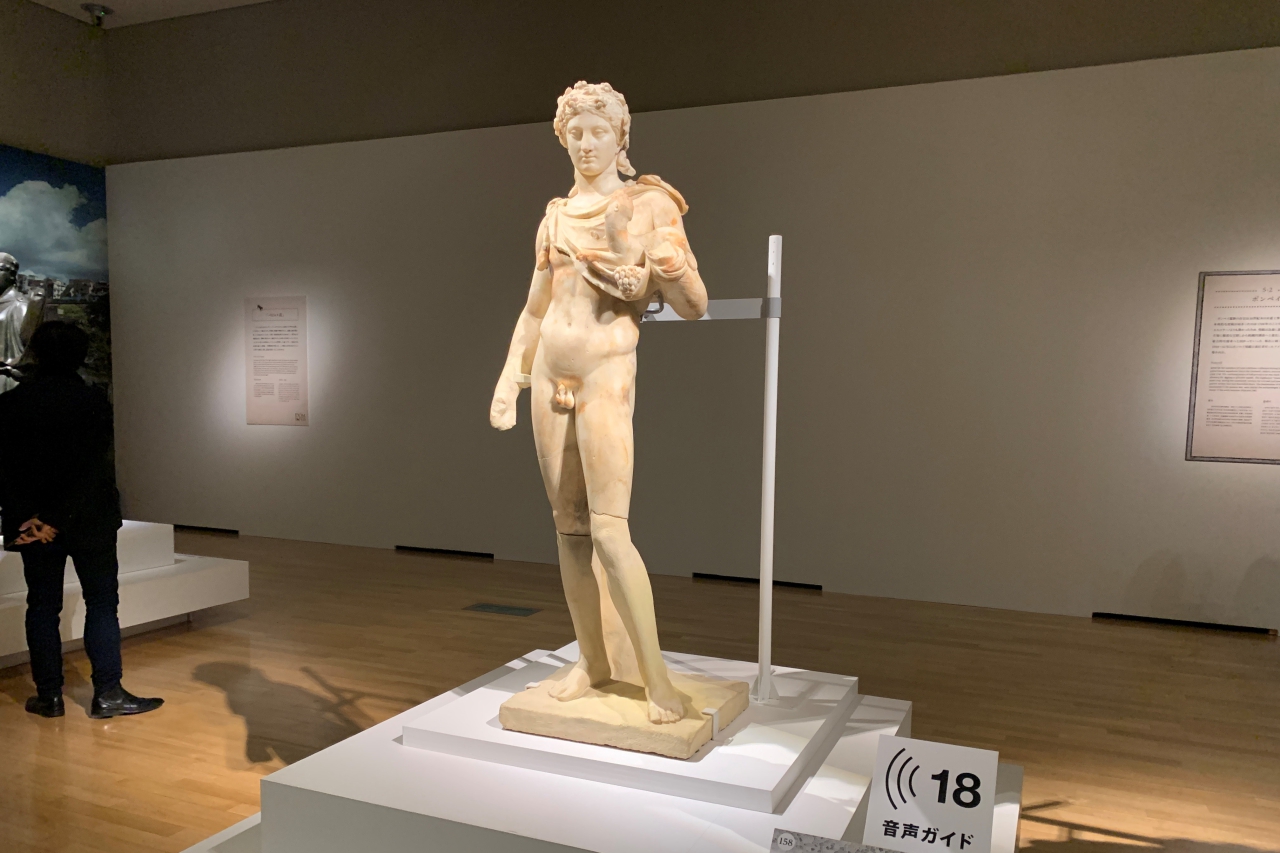
《Bucks holding a leopard (Dionysus) (27-14 BC) Nora Historical Archaeological Museum Collection
The archaeological excavation used to have a strong meaning of "treasure hunting" to acquire works of art, but now it seems that the protection of archaeological sites and archaeological finds is more important than excavation. In Chapter 5, which will be the epilogue, the 18th century will be exhibited, such as the early excavated "Satyr of the ropewalk" and the representative excavation of the University of Tokyo's academic research team, "Bucks holding a leopard (Dionysus)". We look back on the history of excavation of the Pompeii ruins from to the present.
As the latest information at the end, a documentary video also introduced the ongoing restoration work of Alexander the Great's Mosaic.
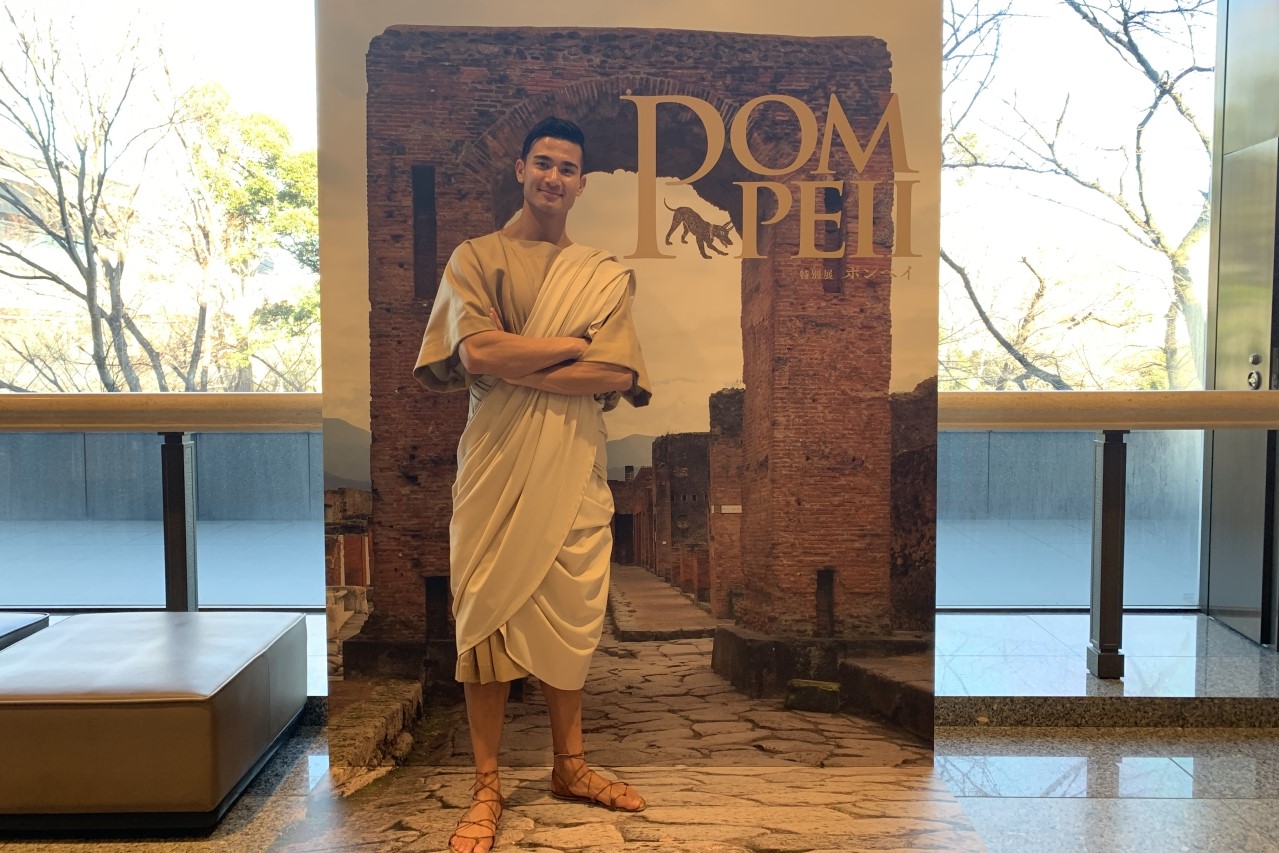
Maybe you can take a commemorative photo with Pompeii?
In addition, this exhibition is generous, and photography is OK only for personal use! In connection with that, on the official Instagram of the exhibition (@ pompeii2022), along with "# Pompeii-kun" dressed as model AMON, we will proceed with a plan to introduce "shining" recommended shooting spots in the venue. Pompeii may appear at the venue during the session.
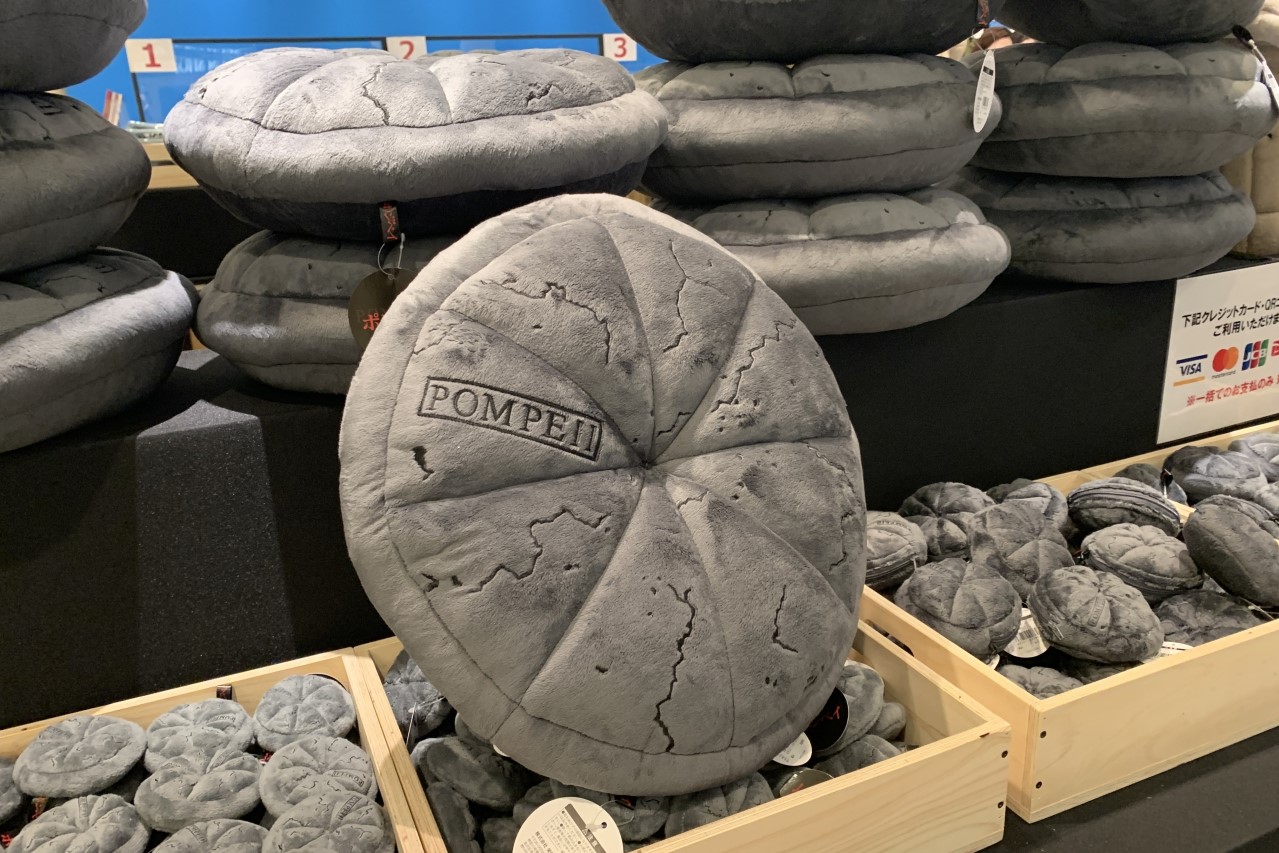
State of the museum shop

State of the museum shop
Many original goods for this exhibition are on sale at the museum shop, but the cushions for the above-mentioned "Carbonized Bread" are also available. There is an indescribable taste in the expression of cracks. Also, cute collaboration goods with Pompompurin! If you are a fan, don't miss this limited edition product that can only be bought here by Pudding, who has been recolored in an ancient Roman style.
It was a wonderful exhibition where you can feel the meaning of the catch phrase "I was there."
The special exhibition "Pompeii" will be held from January 14th (Friday) to April 3rd (Sunday), 2022. Why don't you immerse yourself in the romantic atmosphere of ancient times through a group of works that still have a lively presence beyond the time of 2000.
Outline of the special exhibition "Pompeii"
| Legislative session | January 14th (Friday) -April 3rd (Sunday), 2022 |
| venue | Tokyo National Museum Heiseikan |
| Opening hours | 9:30 am to 5:00 pm |
| closing day | Monday, 3/22 (Tuesday) * However, 3/21 (Monday / holiday) and 3/28 (Monday) are open. |
| Admission fee | General 2,100 yen, college student 1,300 yen, high school student 900 yen * Advance reservation (reserved-seat ticket) is recommended for this exhibition. Please check the official website of the exhibition for details. |
| Organizer | Tokyo National Museum, Naples National Archaeological Museum, Asahi Shimbun, NHK, NHK Promotion |
| inquiry | 050-5541-8600 (Hello dial) |
| Exhibition official website | https://pompeii2022.jp/ |
* The content of the article is as of the time of publication (2022/1/20). Please note that the information may differ from the latest information.
<Past exhibition report>
Special Exhibition "Experience! Traditional Japanese Performing Arts" Venue Report Bringing together the arts that Japan has protected and passed down (held at the Tokyo National Museum Hyokeikan until March 13)
[Tokyo National Museum] Special Exhibition "Kuya Jonin and Rokuharamitsuji" Press Release Report
Click here for a list


